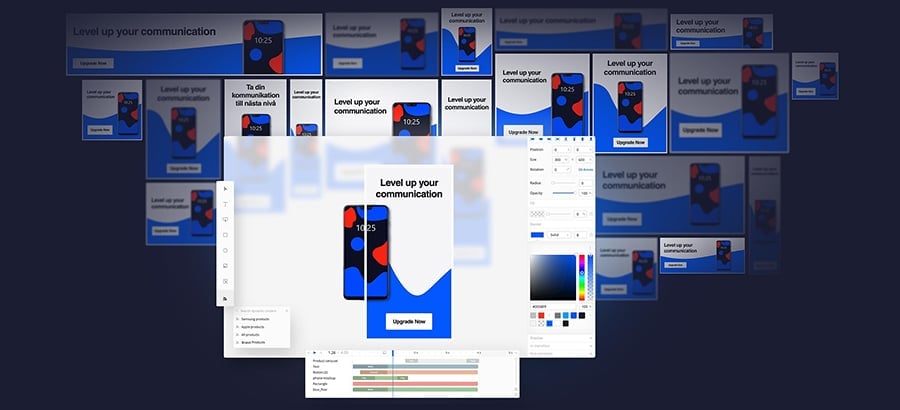With the digital transformation in full swing across several industries, perhaps an overlooked component is the importance of social media. Many businesses are under utilising the value of a strong social media strategy or simply fail to appreciate its high potential.
Latest stats show why that might be a bad idea:
- 43% of consumers use social media to discover new products and services
- 78% of people are willing to do business with a company if they have a positive experience with them on social media
- 33% of audiences use social media as their first port-of-call when attempting to contact a company
Whether you want to engage gen-z on TikTok, kickstart conversations with senior stakeholders on LinkedIn, or simply build brand awareness and drive recognition amongst consumers on Facebook or Twitter, social media engagement is key.
If you’re not engaging audiences, you’re not delivering a strong enough strategy.
Read on to learn how to boost your social media engagement across both organic and paid strategies.
The importance of social media engagement
An effective social media strategy will usually contain the following:
- Key channel objectives based on what you want to achieve as a business
- A robust content strategy that drives key messaging, engages an audience and compels them to deliver your channel objective, be it to click, to purchase or to watch
- A visual design element that encourages scroll-stopping and encourages a user to interact
- A defined community management strategy to convert conversations with audiences into something more tangible
- A routine performance and reporting structure that identifies strategy strengths and weaknesses, key metric growth, content insights and key learnings for development
The ‘golden thread’ that runs through each of those elements is engagement. Activating your audience is key to growing your pages, driving consistent traffic back to site, developing brand recognition and also increasing positive brand perception.
What’s more, social media users like to engage; they don’t scroll through Instagram, Twitter or any other platform for a one-way experience. They seek connections and engagement, be it with friends, colleagues or companies.
On a platform level, social media engagement is crucial. The more likes, comments, shares, views and clicks your content generates, the more visible your content will be within user feeds. Each platform possesses a unique channel algorithm that dictates how visible your content is on the feed and who it is seen by. Some platforms may favour video, others long-form articles. Either way, it is important that you know the channel you are posting on and the kind of content it encourages. Our previous guide to social media strategies could help you here.
Beyond the key metrics, social media engagement is crucial to meeting your strategic objectives. If you are using social media to sell, strong engagement will ultimately lead to more sales; if you are using social media to demonstrate thought leadership, high engagement levels will provide credibility and proof of knowledge.
In short, social media engagement is the fuel which your strategy needs to meet its objectives and targets.
Social media engagement challenges
We are living in an age where paid content is king, so it is vital that your organic content still delivers from an ‘always-on’ perspective. A major challenge that businesses have experienced in recent years is the decline of organic social media performance. But that isn’t to say that organic is dead. Far from it.
Social media is often the first door that users seek out when they want to talk with a company. Therefore, your always-on, organic strategy needs to be effective to present your company in the best light.
With paid activity so prominent on social media, organic content now reaches on average just 6% of your following. You have to make every post count and ensure it is optimised enough to encourage that 6% to engage. While such a low percentage may seem bleak, on some channels the reach Is likely to be higher.
In fact, latest stats from 2022 show that organic content could be making a comeback. On LinkedIn, organic session engagement has grown by a record 22% during the past year. That stat alone should tell you the importance of organic social media engagement.
Paid social media plays an important role in social media strategies. In many ways, paid social media is an entire industry in itself: agencies and businesses hire specific specialists to oversee their paid strategies, such is the importance of getting it right.
If you want to drive constant engagement and convert those post actions into results that can transform business success, you need a paid social media strategy. Hootsuite have recently published 56 vital paid statistics for 2022, but to pick out just a handful:
- Ad revenue Is projected to reach over $173 billion in 2022, which emphasises how important businesses view paid content
- Ads are proven to increase brand awareness – up to 50% in some cases
- Social media spend will account for 33% of all digital budgets in 2022 – a 17% YOY increase
If you can crack the code to paid social media, your engagement levels will sky-rocket. But if you are to leave this blog post with just one takeaway, it’s this: it shouldn’t be either/or.
The key to consistent and effective social media engagement is a strategy that deploys both an organic and paid approach.
Strategies to increase social media engagement
There isn’t one trick that will convert your brand from zero to hero overnight, but there are certain approaches you can adapt or implement that are proven to increase social media engagement.
Remember that engagement differs by platform though, and what works on LinkedIn, for example, might not work for TikTok.
Here are 4 tips to increase your engagement levels:
1. Video, video, video
Across the board, platforms are emphasising the need to integrate video into social media strategies. On Twitter, content with video drives 10x more engagement, whilst video on Instagram drives as much as twice as many comments and interactions compared to image and carousel posts. Instagram are heavily pushing reels, whilst Stories have an 86% completion rate. TikTok, meanwhile, has seen an explosion in sign-ups and activities since 2020, with ad revenue expected to triple by 2024.
2. Customer service is crucial
A happy customer is a lucrative customer. Whether you are consumer or corporate facing, building positive relationships with your audience is very important. There are loads of stats out there that show the link between positive engagement and increase in trust and brand loyalty. Put simply, if a social media user always has a positive experience with your brand, they will keep coming back for more, which ultimately equals more engagement.
3. Leverage your senior figures
From a B2B perspective, there is a clear upward trend in the success of incorporating your senior figures within your social media strategy. Senior figure spotlights, op-eds and long-form commentary pieces from your CEO, and other content featuring your key decision-makers helps to build their personal profile, emphasise thought leadership and increase brand credibility. On LinkedIn, individual profiles are known to generate 15x more engagement than a business channel: just imagine the impact you can generate by leveraging your CEO’s huge and loyal audience.
4. Post based on algorithm, not KPIs
Whether you’re a freelancer, an in-house department or working at an agency, we can all fall into the trap of thinking more content = more value for money for your client or company. But daily posting may be detrimental to your engagement levels. Yes, some platforms favour constant content publication, but others prefer a more thoughtful approach. When deploying your content strategy, make sure you understand the channel algorithm and how it ranks content.
Tips on how to measure social media engagement
Now that we better understand the importance of social media engagement and how to generate more of it, it is important to know how best to measure engagement. This is where performance reporting comes in.
Depending on your company, they may want to track key metric growth across a daily, weekly, fortnightly or monthly timeframe. Either way, performance tracking is vital to understand the impact of social media engagement and how it is being generated.
In the current social media landscape, each platform tends to possess its own native insights, which vary in detail and use. Depending on the level of reporting that is expected, these native insights often provide more than enough detail to understand individual content performance, analysis around video performance and the demographic of your post engagers.
If you are In need of more detailed and tangible analysis, a social listening software might be more useful.
For more insight into the importance of social media within a wider digital transformation, read our guide on Social media tranformation. Or to find out more about the Bannerflow product and how it could transform your social media engagement book a demo to experience our platform in action.







